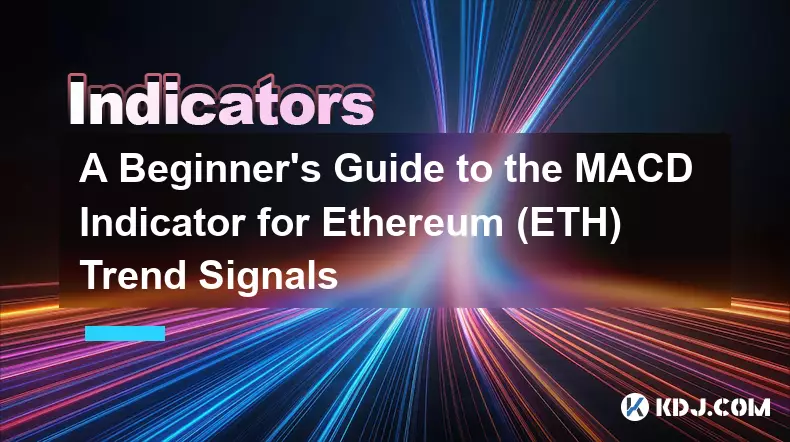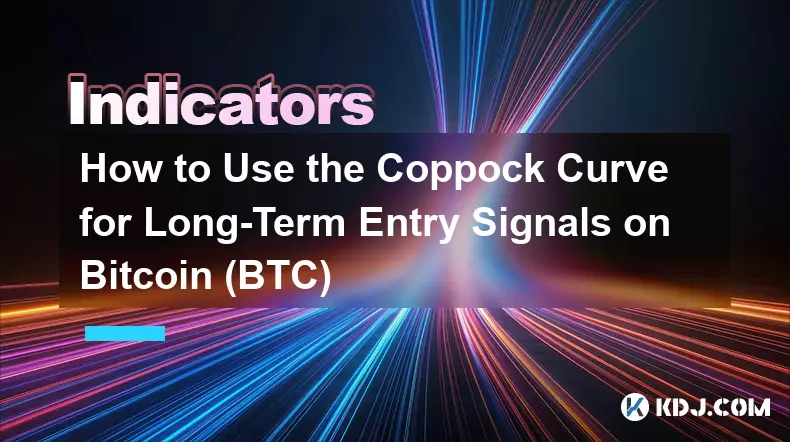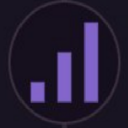-
 bitcoin
bitcoin $99177.955738 USD
-7.32% -
 ethereum
ethereum $3187.183061 USD
-12.38% -
 tether
tether $0.999809 USD
0.00% -
 xrp
xrp $2.117933 USD
-9.42% -
 bnb
bnb $906.710033 USD
-9.17% -
 solana
solana $149.367737 USD
-10.74% -
 usd-coin
usd-coin $0.999816 USD
0.01% -
 tron
tron $0.281498 USD
-0.38% -
 dogecoin
dogecoin $0.156292 USD
-8.00% -
 cardano
cardano $0.500744 USD
-10.19% -
 hyperliquid
hyperliquid $38.087358 USD
-4.58% -
 chainlink
chainlink $14.097831 USD
-8.54% -
 bitcoin-cash
bitcoin-cash $463.329916 USD
-9.22% -
 ethena-usde
ethena-usde $0.999078 USD
-0.01% -
 unus-sed-leo
unus-sed-leo $9.475862 USD
-0.79%
A Beginner's Guide to the MACD Indicator for Ethereum (ETH) Trend Signals
The MACD helps Ethereum traders spot trend reversals and momentum shifts through crossovers, divergences, and histogram changes across multiple timeframes.
Nov 03, 2025 at 01:54 pm

Understanding the MACD Indicator in Ethereum Trading
1. The Moving Average Convergence Divergence (MACD) is a momentum-based technical indicator widely used by traders to identify potential trend reversals and momentum shifts in Ethereum's price action. It consists of three main components: the MACD line, the signal line, and the histogram. These elements work together to provide visual cues about whether bullish or bearish momentum is gaining strength.
2. The MACD line is calculated by subtracting the 26-period Exponential Moving Average (EMA) from the 12-period EMA. This line reflects short-term momentum compared to longer-term momentum. When this line crosses above zero, it suggests that short-term momentum is overtaking long-term momentum, which can indicate bullish sentiment for ETH.
3. The signal line, typically a 9-period EMA of the MACD line, acts as a trigger for buy and sell signals. Traders watch for crossovers between the MACD line and the signal line. A crossover above the signal line is generally interpreted as a buy signal, while a crossover below may suggest a selling opportunity.
4. The histogram represents the difference between the MACD line and the signal line. Expanding green bars indicate increasing bullish momentum, while shrinking or red bars suggest weakening momentum or bearish pressure. This visual representation helps traders assess the strength behind price movements in Ethereum’s volatile market.
Key MACD Signals for Ethereum Trend Analysis
1. A bullish signal occurs when the MACD line crosses above the signal line, especially when both are below zero. This scenario often indicates that bearish momentum is fading and buyers are beginning to take control. For Ethereum, such signals can precede strong upward moves, particularly after prolonged downtrends.
2. Conversely, a bearish signal forms when the MACD line crosses below the signal line, particularly when both lines are above zero. This suggests that upward momentum is slowing and sellers may be gaining influence. In the context of ETH, these signals are closely watched during overbought conditions or after sharp rallies.
3. Divergences between the MACD and Ethereum’s price can reveal hidden shifts in market sentiment. A bullish divergence happens when ETH makes a lower low, but the MACD forms a higher low, indicating underlying buying strength. A bearish divergence occurs when ETH reaches a higher high, yet the MACD peaks at a lower level, signaling potential exhaustion.
4. Zero-line crossovers also carry significant weight. When the MACD line moves above zero, it confirms that the short-term average is now above the long-term average, reinforcing a bullish trend. When it drops below zero, the opposite holds true, suggesting a bearish phase may be underway.
Practical Tips for Using MACD with ETH Charts
1. Use multiple timeframes to confirm MACD signals. A crossover on the 4-hour chart might be more reliable if supported by a similar signal on the daily chart. Scalpers often monitor the 15-minute or 1-hour MACD, while swing traders focus on daily readings for stronger confirmation.
2. Combine the MACD with other indicators like RSI or volume analysis to reduce false signals. Ethereum’s price can experience sudden spikes due to news or whale activity, leading to misleading MACD crossovers. Adding volume data can help validate whether a crossover reflects genuine market interest.
3. Adjust MACD settings cautiously. While the default (12, 26, 9) works well for most scenarios, some traders modify the periods to suit ETH’s volatility. Shorter settings may generate faster signals but increase noise; longer settings smooth out data but lag behind price action.
4. Watch for histogram compression. When the bars narrow significantly, it often precedes a strong breakout in either direction. For Ethereum, known for explosive moves, this can be an early warning sign of an impending surge or drop.
Frequently Asked Questions
What does a MACD crossover below the signal line mean for ETH?It typically indicates weakening bullish momentum and may signal a potential downward move. Traders interpret this as a possible exit point or short entry, especially if confirmed by other bearish patterns.
Can MACD predict exact price levels for Ethereum?No, the MACD does not forecast specific price targets. It measures momentum and trend direction, helping traders assess whether upward or downward pressure is building, not where the price will reach.
Is MACD effective during low-volume periods for ETH?Its effectiveness diminishes when trading volume is low, as price movements may lack conviction. During such times, MACD signals can produce false entries, so caution is advised without additional confirmation tools.
How often should I check MACD signals on ETH charts?Frequency depends on your strategy. Day traders may review every few minutes, while position holders might analyze daily or weekly charts. Consistency in timeframe alignment with your trading style is key.
Disclaimer:info@kdj.com
The information provided is not trading advice. kdj.com does not assume any responsibility for any investments made based on the information provided in this article. Cryptocurrencies are highly volatile and it is highly recommended that you invest with caution after thorough research!
If you believe that the content used on this website infringes your copyright, please contact us immediately (info@kdj.com) and we will delete it promptly.
- Bitcoin's Wild Ride: Saylor, Kiyosaki, and the Quest for $200K
- 2025-11-05 10:50:13
- Culex, Cardano, and Aster: A Crypto Cocktail of Mosquitoes, Dips, and CZ Fuel
- 2025-11-05 11:00:17
- Crypto Presales, Coin Growth, and Established Coins: Navigating the 2025 Buzz
- 2025-11-05 11:00:17
- La Culex, Crypto Investment, and Pudgy Penguins: A NYC Perspective
- 2025-11-05 10:30:13
- Zcash Defies Crypto Crash: Reversal Risk on the Horizon?
- 2025-11-05 11:00:01
- Score Big with BetMGM: NBA, NFL, and the TOP150 Bonus Code
- 2025-11-05 08:50:13
Related knowledge

Using TradingView for crypto: essential tips and tools for chart analysis.
Nov 05,2025 at 04:30am
Mastering Chart Types on TradingView1. Selecting the right chart type is crucial for accurate crypto analysis. The default candlestick chart remains a...

Technical analysis for crypto: using RSI and MACD to find trading signals.
Nov 03,2025 at 03:18pm
Decentralized Exchanges Are Reshaping Trading Dynamics1. Decentralized exchanges (DEXs) have gained significant traction by eliminating intermediaries...

Reading crypto charts for beginners: understanding candlestick patterns.
Nov 05,2025 at 02:55am
Introduction to Candlestick Charts in Crypto Trading1. Candlestick charts are one of the most widely used tools in cryptocurrency trading, offering vi...

The Best Exponential Moving Average (EMA) Settings for Crypto Swing Trading
Oct 25,2025 at 04:55pm
The Best Exponential Moving Average (EMA) Settings for Crypto Swing TradingSwing trading in the cryptocurrency market relies heavily on identifying tr...

How to Use the Coppock Curve for Long-Term Entry Signals on Bitcoin (BTC)
Oct 31,2025 at 03:01pm
Understanding the Coppock Curve in Bitcoin Analysis1. The Coppock Curve is a momentum indicator originally designed for stock market indices but has f...

A Beginner's Guide to Finding Divergence with the MACD on the Solana (SOL) Chart
Oct 26,2025 at 12:36pm
Understanding MACD and Its Role in Solana Trading1. The Moving Average Convergence Divergence (MACD) is a momentum indicator widely used in cryptocurr...

Using TradingView for crypto: essential tips and tools for chart analysis.
Nov 05,2025 at 04:30am
Mastering Chart Types on TradingView1. Selecting the right chart type is crucial for accurate crypto analysis. The default candlestick chart remains a...

Technical analysis for crypto: using RSI and MACD to find trading signals.
Nov 03,2025 at 03:18pm
Decentralized Exchanges Are Reshaping Trading Dynamics1. Decentralized exchanges (DEXs) have gained significant traction by eliminating intermediaries...

Reading crypto charts for beginners: understanding candlestick patterns.
Nov 05,2025 at 02:55am
Introduction to Candlestick Charts in Crypto Trading1. Candlestick charts are one of the most widely used tools in cryptocurrency trading, offering vi...

The Best Exponential Moving Average (EMA) Settings for Crypto Swing Trading
Oct 25,2025 at 04:55pm
The Best Exponential Moving Average (EMA) Settings for Crypto Swing TradingSwing trading in the cryptocurrency market relies heavily on identifying tr...

How to Use the Coppock Curve for Long-Term Entry Signals on Bitcoin (BTC)
Oct 31,2025 at 03:01pm
Understanding the Coppock Curve in Bitcoin Analysis1. The Coppock Curve is a momentum indicator originally designed for stock market indices but has f...

A Beginner's Guide to Finding Divergence with the MACD on the Solana (SOL) Chart
Oct 26,2025 at 12:36pm
Understanding MACD and Its Role in Solana Trading1. The Moving Average Convergence Divergence (MACD) is a momentum indicator widely used in cryptocurr...
See all articles










































































